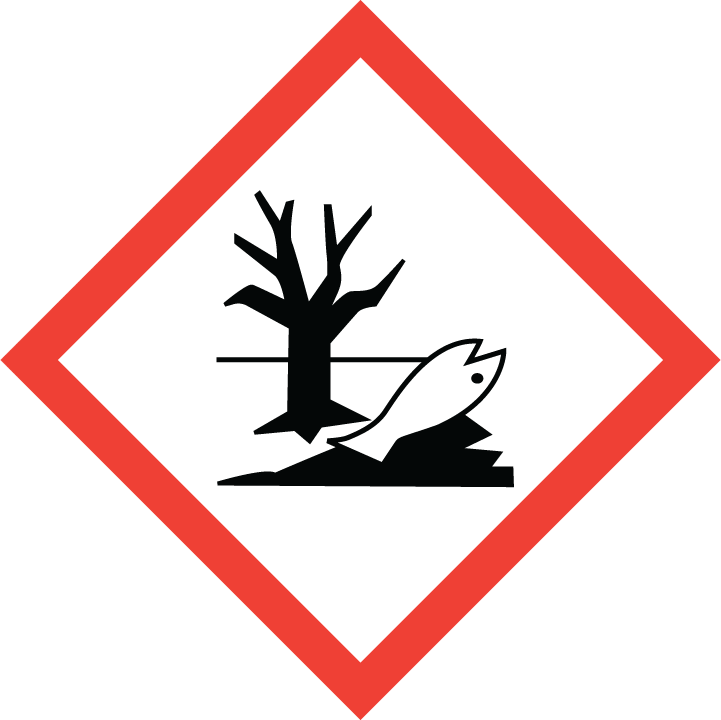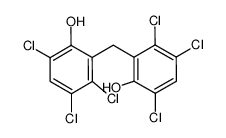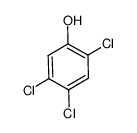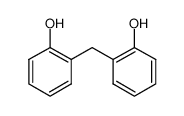1.Identification
1.1 GHS Product identifier
| Product name | hexachlorophene |
|---|
1.2 Other means of identification
| Product number | - |
|---|---|
| Other names | Phenol, 2,2‘-methylenebis[3,4,6-trichloro- |
1.3 Recommended use of the chemical and restrictions on use
| Identified uses | For industry use only. |
|---|---|
| Uses advised against | no data available |
1.4 Supplier's details
| Company | MOLBASE (Shanghai) Biotechnology Co., Ltd. |
|---|---|
| Address | Floor 4 & 5, Building 12, No. 1001 North Qinzhou Road, Xuhui District, Shanghai, China |
| Telephone | +86(21)64956998 |
| Fax | +86(21)54365166 |
1.5 Emergency phone number
| Emergency phone number | +86-400-6021-666 |
|---|---|
| Service hours | Monday to Friday, 9am-5pm (Standard time zone: UTC/GMT +8 hours). |
2.Hazard identification
2.1 Classification of the substance or mixture
Acute toxicity - Oral, Category 3
Acute toxicity - Dermal, Category 3
Hazardous to the aquatic environment, short-term (Acute) - Category Acute 1
Hazardous to the aquatic environment, long-term (Chronic) - Category Chronic 1
2.2 GHS label elements, including precautionary statements
| Pictogram(s) |   |
|---|---|
| Signal word | Danger |
| Hazard statement(s) | H301 Toxic if swallowed H311 Toxic in contact with skin H410 Very toxic to aquatic life with long lasting effects |
| Precautionary statement(s) | |
| Prevention | P264 Wash ... thoroughly after handling. P270 Do not eat, drink or smoke when using this product. P280 Wear protective gloves/protective clothing/eye protection/face protection. P273 Avoid release to the environment. |
| Response | P301+P310 IF SWALLOWED: Immediately call a POISON CENTER/doctor/… P321 Specific treatment (see ... on this label). P330 Rinse mouth. P302+P352 IF ON SKIN: Wash with plenty of water/... P312 Call a POISON CENTER/doctor/…if you feel unwell. P361+P364 Take off immediately all contaminated clothing and wash it before reuse. P391 Collect spillage. |
| Storage | P405 Store locked up. |
| Disposal | P501 Dispose of contents/container to ... |
2.3 Other hazards which do not result in classification
none
3.Composition/information on ingredients
3.1 Substances
| Chemical name | Common names and synonyms | CAS number | EC number | Concentration |
|---|---|---|---|---|
| hexachlorophene | hexachlorophene | 70-30-4 | none | 100% |
4.First-aid measures
4.1 Description of necessary first-aid measures
General advice
Consult a physician. Show this safety data sheet to the doctor in attendance.
If inhaled
Fresh air, rest.
In case of skin contact
Remove contaminated clothes. Rinse and then wash skin with water and soap. Refer for medical attention .
In case of eye contact
Rinse with plenty of water (remove contact lenses if easily possible).
If swallowed
Rinse mouth. Rest. Give a slurry of activated charcoal in water to drink. Refer immediately for medical attention.
4.2 Most important symptoms/effects, acute and delayed
Inhalation of dust is poisonous; irritating to mucous membranes. Eye and skin irritant. Poisonous if swallowed. Symptoms following ingestion include anorexia, nausea, vomiting, abdominal cramps, and diarrhea. Dehydration may be severe and may be associated with shock. (USCG, 1999)
4.3 Indication of immediate medical attention and special treatment needed, if necessary
Other therapies. Though this compound is quite toxic systemically and enhanced clearance methods would appear beneficial, there is no evidence to support the efficacy of hemodialysis, peritoneal dialysis, hemoperfusion, or exchange transfusion.
5.Fire-fighting measures
5.1 Extinguishing media
Suitable extinguishing media
If material on fire or involved in fire: Extinguish fire using agent suitable for type of surrounding fire. (Material itself does not burn or burns with difficulty.) Use water in flooding quantities as fog. Use foam, dry chemical or carbon dioxide. Keep run-off waste out of sewers and water sources.
5.2 Specific hazards arising from the chemical
Special Hazards of Combustion Products: Contain toxic and irritating chloride fumes. Behavior in Fire: Decomposes to produce toxic and irritating gases. (USCG, 1999)
5.3 Special protective actions for fire-fighters
Wear self-contained breathing apparatus for firefighting if necessary.
6.Accidental release measures
6.1 Personal precautions, protective equipment and emergency procedures
Use personal protective equipment. Avoid dust formation. Avoid breathing vapours, mist or gas. Ensure adequate ventilation. Evacuate personnel to safe areas. Avoid breathing dust. For personal protection see section 8.
6.2 Environmental precautions
Personal protection: particulate filter respirator adapted to the airborne concentration of the substance. Do NOT let this chemical enter the environment. Sweep spilled substance into covered sealable containers. If appropriate, moisten first to prevent dusting. Carefully collect remainder. Then store and dispose of according to local regulations.
6.3 Methods and materials for containment and cleaning up
Pick up and arrange disposal. Sweep up and shovel. Keep in suitable, closed containers for disposal.
7.Handling and storage
7.1 Precautions for safe handling
Avoid contact with skin and eyes. Avoid formation of dust and aerosols. Avoid exposure - obtain special instructions before use.Provide appropriate exhaust ventilation at places where dust is formed. For precautions see section 2.2.
7.2 Conditions for safe storage, including any incompatibilities
Separated from food and feedstuffs. Store in an area without drain or sewer access. Provision to contain effluent from fire extinguishing.Store at room temperature up to 25°C (77 deg F).
8.Exposure controls/personal protection
8.1 Control parameters
Occupational Exposure limit values
no data available
Biological limit values
no data available
8.2 Appropriate engineering controls
Handle in accordance with good industrial hygiene and safety practice. Wash hands before breaks and at the end of workday.
8.3 Individual protection measures, such as personal protective equipment (PPE)
Eye/face protection
Safety glasses with side-shields conforming to EN166. Use equipment for eye protection tested and approved under appropriate government standards such as NIOSH (US) or EN 166(EU).
Skin protection
Wear impervious clothing. The type of protective equipment must be selected according to the concentration and amount of the dangerous substance at the specific workplace. Handle with gloves. Gloves must be inspected prior to use. Use proper glove removal technique(without touching glove's outer surface) to avoid skin contact with this product. Dispose of contaminated gloves after use in accordance with applicable laws and good laboratory practices. Wash and dry hands. The selected protective gloves have to satisfy the specifications of EU Directive 89/686/EEC and the standard EN 374 derived from it.
Respiratory protection
Wear dust mask when handling large quantities.
Thermal hazards
no data available
9.Physical and chemical properties
| Physical state | off-white to purple powder |
|---|---|
| Colour | Crystals from benzene |
| Odour | ODORLESS OR HAS ONLY SLIGHTLY PHENOLIC ODOR |
| Melting point/ freezing point | 160 - 166ºC |
| Boiling point or initial boiling point and boiling range | 166ºC |
| Flammability | Combustible. Gives off irritating or toxic fumes (or gases) in a fire. |
| Lower and upper explosion limit / flammability limit | no data available |
| Flash point | 238.6ºC |
| Auto-ignition temperature | no data available |
| Decomposition temperature | no data available |
| pH | no data available |
| Kinematic viscosity | no data available |
| Solubility | less than 1 mg/mL at 20°C |
| Partition coefficient n-octanol/water (log value) | no data available |
| Vapour pressure | 8.3X10-11 mm Hg at 25°C (est) |
| Density and/or relative density | 1.713g/cm3 |
| Relative vapour density | no data available |
| Particle characteristics | no data available |
10.Stability and reactivity
10.1 Reactivity
no data available
10.2 Chemical stability
Stable under recommended storage conditions.
10.3 Possibility of hazardous reactions
HEXACHLOROPHENE is incompatible with strong oxidizers. It forms salts with alkalis and alkaline earths.
10.4 Conditions to avoid
no data available
10.5 Incompatible materials
Oxidizers.
10.6 Hazardous decomposition products
... When heated to decomposition, it emits highly toxic fumes of ... /hydrogen chloride/.
11.Toxicological information
Acute toxicity
- Oral: LD50 Rat oral 56 mg/kg
- Inhalation: no data available
- Dermal: no data available
Skin corrosion/irritation
no data available
Serious eye damage/irritation
no data available
Respiratory or skin sensitization
no data available
Germ cell mutagenicity
no data available
Carcinogenicity
Classification of carcinogenicity: 1) evidence in humans: no data; 2) evidence in animals: inadequate. Overall summary evaluation of carcinogenic risk to humans is Group 3: The agent is not classifiable as to its carcinogenicity to humans. /From table/
Reproductive toxicity
no data available
STOT-single exposure
no data available
STOT-repeated exposure
no data available
Aspiration hazard
no data available
12.Ecological information
12.1 Toxicity
- Toxicity to fish: LC50; Species: Pimephales promelas (Fathead minnow) age 30 days, length 20.1 mm, weight 0.103 g; Conditions: freshwater, flow through, 24.3°C, pH 7.30, hardness 51.1 mg/L CaCO3, alkalinity 45.8 mg/L CaCO3, dissolved oxygen 5.8 mg/L; Concentration: 21 ug/L for 96 hr (95% confidence interval: 19-23 ug/L) /99% purity
- Toxicity to daphnia and other aquatic invertebrates: EC50; Species: Daphnia magna (Water Flea) age <24 hr neonate; Conditions: freshwater, static, 21°C, pH 7.6; Concentration: 0.000487 mM for 24 hr; Effect: intoxication, immobilization
- Toxicity to algae: no data available
- Toxicity to microorganisms: no data available
12.2 Persistence and degradability
AEROBIC: Hexachlorophene, present at 100 mg/L, reached 0% of its theoretical BOD in 4 weeks using an activated sludge inoculum at 30 mg/L in the Japanese MITI test(1). Radio-labeled C14-hexachlorophene was not biodegraded in surface water from the Skidaway River, GA(2). In sediments from Skidaway River, radio-labeled C14-hexachlorophene was degraded with a half-life of 290 days(2).
12.3 Bioaccumulative potential
The BCF of hexachlorophene in carp (Cyprinus carpio), exposed for 8 weeks to 2 and 0.2 ug/L were 87-148 and 82-153, respectively(1). BCFs for hexachlorophene in mosquito fish (Gambusia affinis) and snails (Physa sp) are 278 and 970, respectively(2). According to a classification scheme(3), these BCFs suggest the potential for bioconcentration in aquatic organisms is moderate to high(SRC).
12.4 Mobility in soil
The Koc of hexachlorophene has been reported as 91,000(1). According to a classification scheme(2), this Koc value suggests that hexachlorophene is expected to be immobile in soil. The pKa of hexachlorophene is 4.95(3), indicating that this compound will partially exist in anion form in the environment and anions generally do not adsorb more strongly to soils containing organic carbon and clay than their neutral counterparts(4). A study of the mobility in Hagerstown silty clay loam soil TLC (thin layer chormatography) plates using 10 soil fungi and an alga (range of Rf values, 0.01-0.04, avg 0.01) indicated very little movement on the soil TLC plates(5). A monitoring study identified hexachlorophene in humic acid fractions of two sediment samples taken at least eight years after the FDA ban on the over-the-counter sale of cosmetics and drugs containing more than 0.1% hexachlorophene(6). These data indicate that hexachlorophene was strongly associated with organic matter which may have been as a result of covalent binding of the ionizable compound(5-6).
12.5 Other adverse effects
no data available
13.Disposal considerations
13.1 Disposal methods
Product
The material can be disposed of by removal to a licensed chemical destruction plant or by controlled incineration with flue gas scrubbing. Do not contaminate water, foodstuffs, feed or seed by storage or disposal. Do not discharge to sewer systems.
Contaminated packaging
Containers can be triply rinsed (or equivalent) and offered for recycling or reconditioning. Alternatively, the packaging can be punctured to make it unusable for other purposes and then be disposed of in a sanitary landfill. Controlled incineration with flue gas scrubbing is possible for combustible packaging materials.
14.Transport information
14.1 UN Number
| ADR/RID: UN2875 | IMDG: UN2875 | IATA: UN2875 |
14.2 UN Proper Shipping Name
| ADR/RID: HEXACHLOROPHENE |
| IMDG: HEXACHLOROPHENE |
| IATA: HEXACHLOROPHENE |
14.3 Transport hazard class(es)
| ADR/RID: 6.1 | IMDG: 6.1 | IATA: 6.1 |
14.4 Packing group, if applicable
| ADR/RID: III | IMDG: III | IATA: III |
14.5 Environmental hazards
| ADR/RID: yes | IMDG: yes | IATA: yes |
14.6 Special precautions for user
no data available
14.7 Transport in bulk according to Annex II of MARPOL 73/78 and the IBC Code
no data available
15.Regulatory information
15.1 Safety, health and environmental regulations specific for the product in question
| Chemical name | Common names and synonyms | CAS number | EC number |
|---|---|---|---|
| hexachlorophene | hexachlorophene | 70-30-4 | none |
| European Inventory of Existing Commercial Chemical Substances (EINECS) | Listed. | ||
| EC Inventory | Listed. | ||
| United States Toxic Substances Control Act (TSCA) Inventory | Listed. | ||
| China Catalog of Hazardous chemicals 2015 | Listed. | ||
| New Zealand Inventory of Chemicals (NZIoC) | Listed. | ||
| Philippines Inventory of Chemicals and Chemical Substances (PICCS) | Listed. | ||
| Vietnam National Chemical Inventory | Not Listed. | ||
| Chinese Chemical Inventory of Existing Chemical Substances (China IECSC) | Listed. | ||
16.Other information
Information on revision
| Creation Date | Aug 15, 2017 |
|---|---|
| Revision Date | Aug 15, 2017 |
Abbreviations and acronyms
- CAS: Chemical Abstracts Service
- ADR: European Agreement concerning the International Carriage of Dangerous Goods by Road
- RID: Regulation concerning the International Carriage of Dangerous Goods by Rail
- IMDG: International Maritime Dangerous Goods
- IATA: International Air Transportation Association
- TWA: Time Weighted Average
- STEL: Short term exposure limit
- LC50: Lethal Concentration 50%
- LD50: Lethal Dose 50%
- EC50: Effective Concentration 50%
References
- IPCS - The International Chemical Safety Cards (ICSC), website: http://www.ilo.org/dyn/icsc/showcard.home
- HSDB - Hazardous Substances Data Bank, website: https://toxnet.nlm.nih.gov/newtoxnet/hsdb.htm
- IARC - International Agency for Research on Cancer, website: http://www.iarc.fr/
- eChemPortal - The Global Portal to Information on Chemical Substances by OECD, website: http://www.echemportal.org/echemportal/index?pageID=0&request_locale=en
- CAMEO Chemicals, website: http://cameochemicals.noaa.gov/search/simple
- ChemIDplus, website: http://chem.sis.nlm.nih.gov/chemidplus/chemidlite.jsp
- ERG - Emergency Response Guidebook by U.S. Department of Transportation, website: http://www.phmsa.dot.gov/hazmat/library/erg
- Germany GESTIS-database on hazard substance, website: http://www.dguv.de/ifa/gestis/gestis-stoffdatenbank/index-2.jsp
- ECHA - European Chemicals Agency, website: https://echa.europa.eu/








